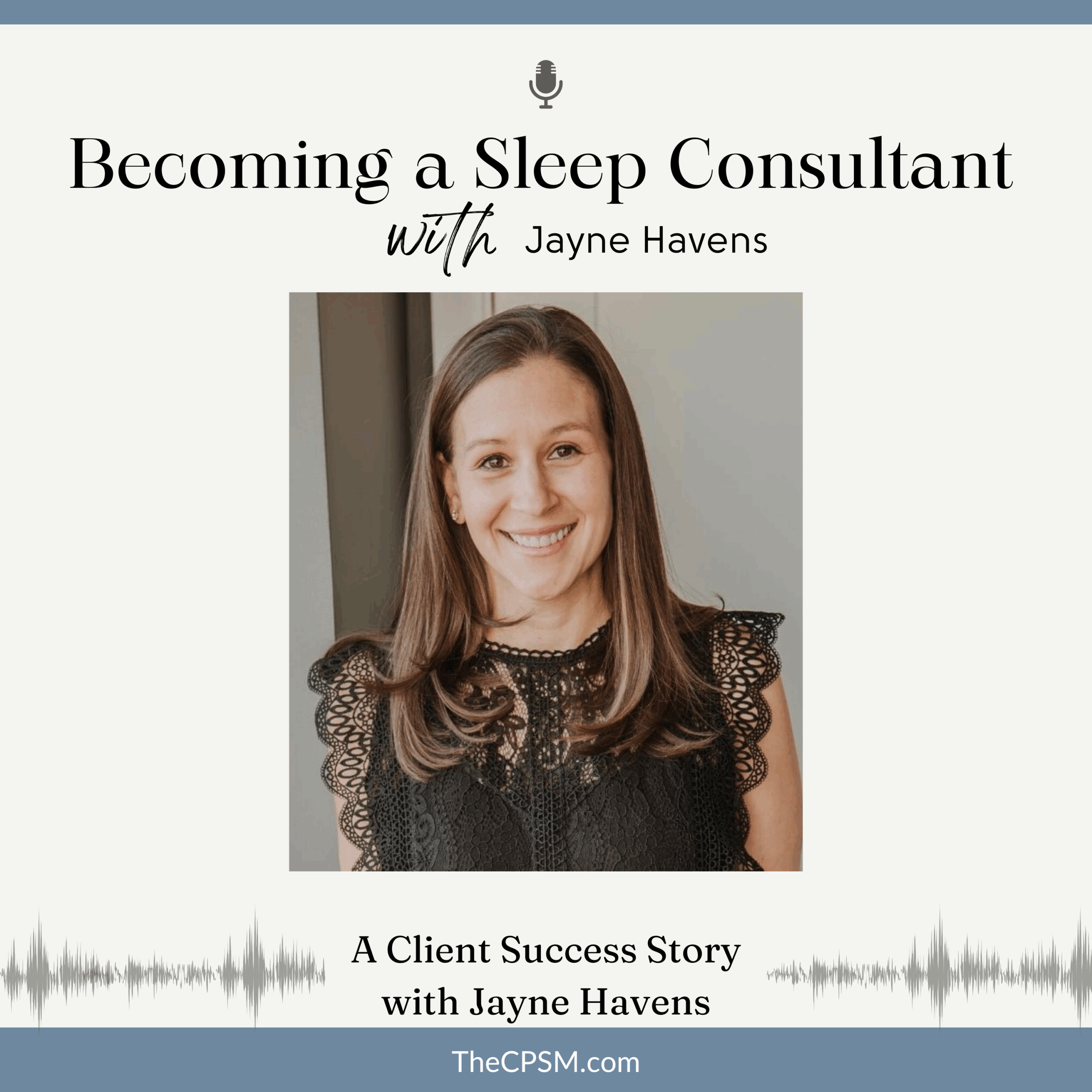Jayne Havens is a certified sleep consultant and the founder of Snooze Fest by Jayne Havens and Center for Pediatric Sleep Management. As a leader in the industry, Jayne advocates for healthy sleep hygiene for children of all ages. Jayne launched her comprehensive sleep consultant certification course so she could train and mentor others to work in this emerging industry.
Meet Jayne Havens
Interested in Becoming a
Sleep Consultant?
Join Our Free Facebook Group
A Client Success Story with Jayne Havens

On this episode of the Becoming a Sleep Consultant podcast, I share the story of Mia, a 27-month-old who was battling bedtime, waking multiple times overnight, and climbing out of her crib. Her parents tried a crib tent, but it wasn’t safe, and it wasn’t solving the problem.
With a clear plan, lots of role play, and a fun technique called the Kissing Game, Mia quickly adjusted to her new sleep rules. Within days she was falling asleep confidently and independently, waiting for her OK-to-Wake clock, and making her parents proud.
This case is a great reminder that toddlers are often more capable than we give them credit for. With a heavy dose of communication and follow through, even the toughest toddler sleep struggles can turn into big wins.
Links:
If you would like to learn more about the Becoming a Sleep Consultant, please join our free Facebook Group or check out our CPSM Website.
Book a free discovery call to learn how you can become a Certified Sleep Consultant here.
Transcript:
Intro: Welcome to Becoming a Sleep Consultant! I’m your host Jayne Havens, a certified sleep consultant and founder of both Snooze Fest by Jayne Havens and Center for Pediatric Sleep Management.
On this podcast, I’ll be discussing the business side of sleep consulting. You’ll have an insider’s view on launching, growing, and even scaling a sleep consulting business. This is not a podcast about sleep training. This is a podcast about business building and entrepreneurship.
Jayne Havens: On today’s episode of the Becoming a Sleep Consultant podcast, I want to share with you a recent success story. I haven’t done one of these in a while, and this is a really good one, so I think it makes for a perfect share.
Mom reached out to me because her 27-month-old daughter was fighting bedtime and waking up multiple times overnight. She had started climbing out of the crib, so mom installed a crib tent, thinking that that would solve the problem. Even with the crib tent, mom was sitting in the room with her and trying to keep her calm at bedtime, and resettling her several times overnight, so she knew she needed some help.
When I spoke to both parents on the discovery call, mom gave me a full rundown of what they were up against, and honestly, it sounded so hard. I also knew that I could help. I was really upfront with these parents that, if they wanted my support, we would need to transition their daughter to a bed and ditch both the crib and the crib tent for safety. While this made both parents pretty anxious, I think I was able to successfully articulate that the tent wasn’t safe, and it wasn’t solving the problem. They decided to trust me and let me lead them to success.
So a little about this child. Her name is Mia. She’s 27 months old, and she’s a total doll. You’re going to have to imagine, but she’s as precious as they come. She speaks in full sentences, she communicates beautifully, and, thankfully, her parents had full confidence that she understood everything they said to her.
For a young two-year-old, this is such an important component to success. I find that when parents undermine their child’s ability to understand, I have a much harder time leading them to the finish line. This was not the case with Mia. I sent them a sleep plan, which included some age-appropriate communication strategies, instructions for role play, and basically two options for sleep training. The first option was to kick it off with the Kissing Game and transition to silent return if she wasn’t staying in her bed, and the second option was extinction with a gate or a knob cover at the door. Mom and dad chose to put the Kissing Game into place, and I was excited to coach them through.
After a very brief family meeting, they took me at a role play. She loved it. She loved it so much that it became her primary way of play for the next few days. She would tuck mommy into bed, and then mommy would tuck her into bed, and then daddy would have a turn. They practiced and practiced, and Mia 100% understood the expectations.
In my experience, most young two-year-olds lack impulse control to stay in bed without the framework of a crib around them. I’m always happy to coach parents through a gradual and parent-present approach, but most often, these young toddlers really do benefit from a physical barrier, as the invisible boundary is just so hard for them to see and understand. That being said, that was not the case with Mia. Mia 100% understood that, as long as she kept her head on her pillow and her feet on the floor, Daddy would come give her kisses until she fell asleep. She loved the game, and she was excited to follow these new sleep rules. I think on night one, she slept straight through until about 5:45 AM.
The next night, we decided to put an OK-to-Wake clock into place, as Mia didn’t have any other way of understanding when it was an acceptable time to start the day. We told her if the light was off, she needed to stay in bed. When the light was on, when it turned green, that’s when she could come out of bed and come get her mommy and daddy. We set the clock to turn on early, maybe even at 5:45 AM, because we wanted to get her a quick win. Mia slept until her clock was green that morning, and she came running in to tell her parents she did it. She was so proud.
From there, we pushed the light back a touch every single day until she was waiting until 6:30 AM for her light to turn on. Amazing—from this tiny little two-year-old. I work a lot with toddlers and preschoolers, and I’ve noticed that they all pretty much listen better for their teachers in school than they do at home for their parents. With this in mind, one little trick that I have up my sleeve is to ask the parents to get a recorded video of the child’s teacher, asking them to follow the rules around bedtime and sleep. This is highly effective because these kids definitely don’t want to disappoint their teachers.
In Mia’s case, she’s home with a nanny and hasn’t started attending school yet, so I offered to play this role for her. I would send Mia videos every other day or so, always introducing myself as her sleep coach, Coach Jayne. From there, I would clearly outline the expectations, even model some breathing exercises, and show her what it looks like to lie in bed with your eyes closed and your body relaxed. I would encourage her to make good choices, keep her body calm, and I would ask her to send me a video in the morning if she waited for her green light. This back-and-forth communication was really helpful for Mia, but it was also really fun for me.
When I get to play this role for kids, I really feel like they get to know me, and they have greater buy-in. I spent two weeks with this family, but truthfully, we got it done within two or three days. I had my wrap-up call with them this afternoon and mom just kept saying how I empowered her to really communicate more effectively with her child. Mia is their first baby, and mom just really didn’t know that she could hold her to such high standards. Mia didn’t need to be trapped under a crib tent. She just needed someone to sit down with her, set some expectations, role play, and follow through.
I share this case with you because it really felt like a bit of a slam dunk, and it reignited my passion to take on these challenging cases. Young two-year-olds who are sleeping in beds are probably my least favorite cases to take on. They’re my least favorite not because I doubt the kids, but because sometimes the parents undermine their child’s ability to understand and follow instructions.
This particular child was super smart and very savvy, and her parents knew it, which made everything easier. But now I have a case study to share with other parents when I hear them casting doubt on their own child. When we hold these kids to their highest abilities, they usually rise to the occasion and make us proud. If you’re already working as a sleep consultant, I hope this quick little story made you smile. If you’re thinking of becoming one, I hope this story gave you those little butterflies in your stomach—the butterflies you feel when you’re feeling a bit nervous but also really excited.
I’m not exaggerating when I say this work is truly the most meaningful work ever. Parents reach out to us often at rock bottom, feeling entirely hopeless, without any ability to see that there’s light at the end of the tunnel. I was able to communicate my confidence to this family and to help them realize that their child was not broken. Their child was simply not clear on the expectations around sleep, and her parents were sending some mixed messages.
Once we cleared up expectations for behavior around bedtime and sleep, Mia rose to the occasion and became the sleeping beauty we all knew she could be. When I say it, I mean it. This truly doesn’t feel like work. If you’d like to explore becoming a sleep consultant, please hop onto my calendar and schedule a call so we can connect. The link to book your call with me is in the show notes below. I can’t wait to connect with you.
Outro: Thank you so much for listening to this episode of the Becoming a Sleep Consultant Podcast. If you enjoyed today’s episode, it would mean so much to me if you would rate, review, and subscribe. When you rate, review, and subscribe, this helps the podcast reach a greater audience. I am so grateful for your support.
If you would like to learn more about how you can become a certified sleep consultant, head over to my Facebook Group, Becoming a Sleep Consultant or to my website thecpsm.com. Thanks so much, and I hope you will tune in for the next episode.
Thank you for your message.
We will contact you shortly!

